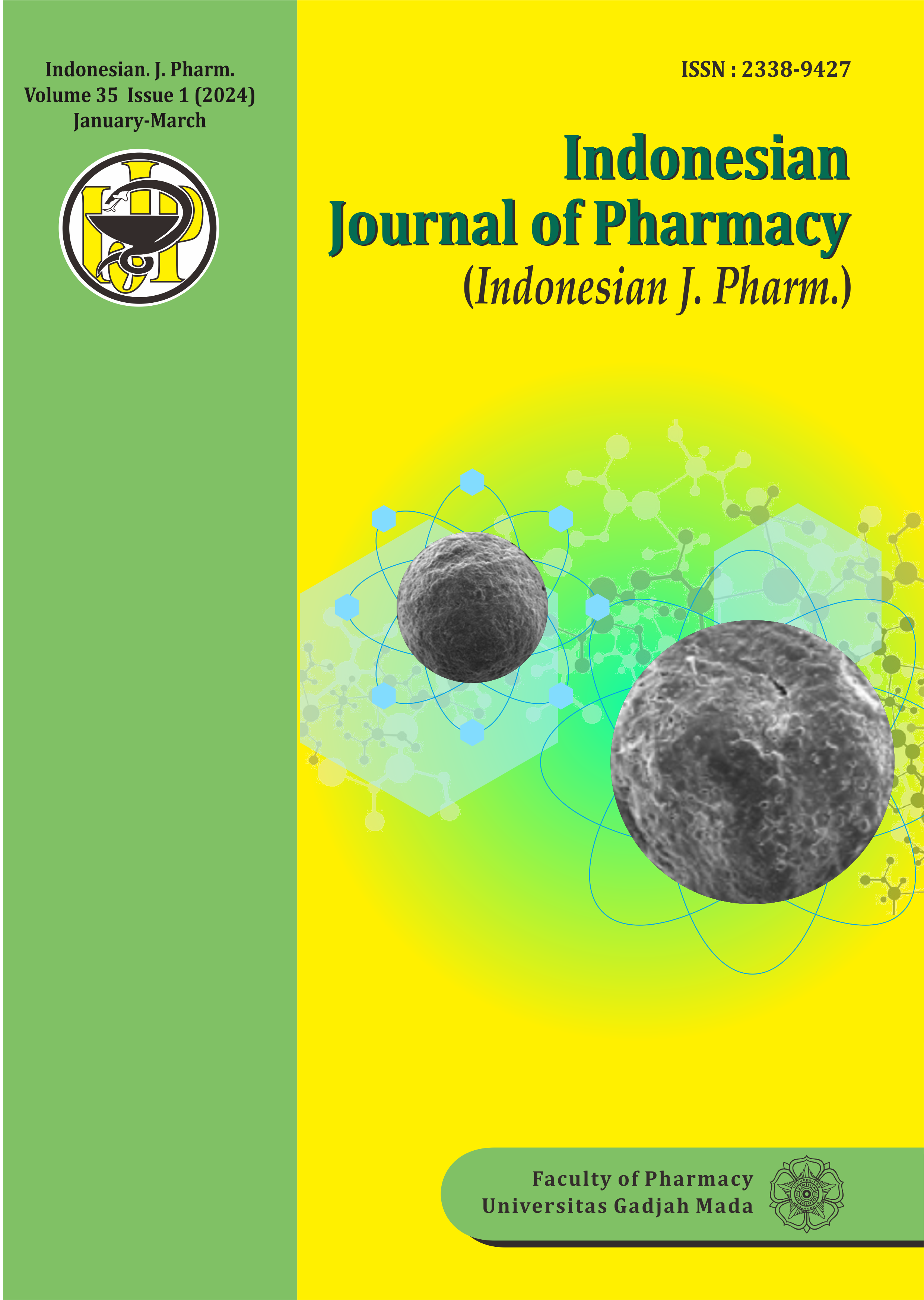LC-HRMS Metabolite Profiling of Lunasia amara Stem Bark and In Silico Study in Breast Cancer Receptors
Abstract
L. amara is a medicinal plant used as an aphrodisiac. Several studies show it has a compound with biological activities such as inhibition of cell proliferation, one of the mechanisms leading to anticancer activities. This study aimed to profile the metabolites and predict activity against two breast cancer receptors (ERα (3ERT) and HER2 (3PPO)) with an in silico approach. Metabolite profiling of water and 80% ethanol extract was analyzed by UHPLC-Q-Orbitrap-HRMS. Also, we performed a radical scavenging activity by 1,1-diphenyl-2-picrylhydrazyl (DPPH). Putative identification of metabolite in L. amara showed the 46 metabolites (4 unknown) were identified and predominantly as quinoline alkaloids. Some of the compounds from glycosides and phenol groups were also identified. From the antioxidant capacity test results, the 80% ethanol extract had a higher radical scavenging capacity than the aqueous extract. Based on the molecular docking results, the highest affinity for the ERα receptor was found in the tested compound tetrahydropapaveroline and exceeded the native 4-OHT ligand. For the HER2 receptor, graveolinine has the highest affinity but is still below the native lapatinib ligand. Ligand interactions with the amino acids Leu 387 and Glu 419 on the active site of the ERα receptor and Phe1004 on the HER2 receptor are thought to play an important role in increasing the energy affinity. Overall, all compounds showed higher affinity for HER2 receptors than ERα. Alkaloids demonstrated anticancer activity. Further research should be conducted to determine the in vitro activity of these compounds on breast cancer cells.
References
Dar, A. M., & Mir, S. (2017). Molecular Docking: Approaches, Types, Applications and Basic Challenges. Journal of Analytical & Bioanalytical Techniques, 08(02). https://doi.org/10.4172/2155-9872.1000356
Dibha, A., Wahyuningsih, S., Ansori, A., Kharisma, V., Widyananda, M., Parikesit, A., Sibero, M., Probojati, R., Murtadlo, A., Trinugroho, J., Sucipto, T., Turista, D., Rosadi, I., Ullah, M., Jakhmola, V., & Zainul, R. (2022). Utilization of Secondary Metabolites in Algae Kappaphycus alvarezii as a Breast Cancer Drug with a Computational Method. Pharmacognosy Journal, 14(3), 536–543. https://doi.org/10.5530/pj.2022.14.68
Grigalius, I., & Petrikaite, V. (2017). Relationship between Antioxidant and Anticancer Activity of Trihydroxyflavones. Molecules, 22(12), 2169. https://doi.org/10.3390/molecules22122169
Gunjan Vasant, B., Gufran, A., Sarita Kumari, Y., Pooja, M., & Brahmeshwar, M. (2020). Lapatinib-loaded nanocolloidal polymeric micelles for the efficient treatment of breast cancer. Journal of Applied Pharmaceutical Science. https://doi.org/10.7324/JAPS.2020.10903
Hanahan, D., & Weinberg, R. A. (2011). Hallmarks of Cancer: The Next Generation. Cell, 144(5), 646–674. https://doi.org/10.1016/j.cell.2011.02.013
Holliday, D. L., & Speirs, V. (2011). Choosing the right cell line for breast cancer research. Breast Cancer Research, 13(4), 215. https://doi.org/10.1186/bcr2889
Kedare, S. B., & Singh, R. P. (2011). Genesis and development of DPPH method of antioxidant assay. Journal of Food Science and Technology, 48(4), 412–422. https://doi.org/10.1007/s13197-011-0251-1
Luthfi, M. J., Kamalrudin, A., & Noor, M. M. (2017). Effects of Lunasia amara Blanco (Sanrego) on Male Fertility: A Preliminary Study on Sperm Proteomic Analysis. Journal of Applied Pharmaceutical Science. https://doi.org/10.7324/JAPS.2017.70812
Macabeo, A. P. G., & Aguinaldo, A. M. (2008). PHCOG REV.: Plant Review Chemical and Phytomedicinal Investigations in Lunasia amara. Pharmacognosy Reviews, 2(4), 10.
May, F. (2014). Novel drugs that target the estrogen-related receptor alpha: Their therapeutic potential in breast cancer. Cancer Management and Research, 225. https://doi.org/10.2147/CMAR.S35024
Meng, X.-Y., Zhang, H.-X., Mezei, M., & Cui, M. (2011). Molecular Docking: A Powerful Approach for Structure-Based Drug Discovery. Current Computer Aided-Drug Design, 7(2), 146–157. https://doi.org/10.2174/157340911795677602
Mutiah, R., Indrawijaya, Y. Y., & Puspita, D. (2020). Study in Silico Compounds In 96% Ethanol Extract of Chrysanthemum cinerariifolium (Trev.) Leaves Towards Alfa Estrogen Receptors. Indonesian Journal of Cancer Chemoprevention, 11(3), 144. https://doi.org/10.14499/indonesianjcanchemoprev11iss3pp144-153
Prescott, T. A. K., Sadler, I. H., Kiapranis, R., & Maciver, S. K. (2007). Lunacridine from Lunasia amara is a DNA intercalating topoisomerase II inhibitor. Journal of Ethnopharmacology, 109(2), 289–294. https://doi.org/10.1016/j.jep.2006.07.036
Rafi, M., Meitary, N., Anggraini Septaningsih, D., & Bintang, M. (2020). Phytochemical Profile And Antioxidant Activity Of Guazuma ulmifolia Leaves Extracts Using Different Solvent Extraction. Indonesian Journal of Pharmacy, 171. https://doi.org/10.22146/ijp.598
Rafi, M., Rismayani, W., Sugiarti, R. M., Syafitri, U. D., Tri, W., & Rohaeti, E. (2021). FTIR-based Fingerprinting Combined with Chemometrics for Discrimination of Sonchus arvensis leaf Extracts and Correlation with Their Antioxidant Activity. 32(2).
Salazar-Aranda, R., Pérez-López, L. A., López-Arroyo, J., Alanís-Garza, B. A., & Waksman de Torres, N. (2009). Antimicrobial and Antioxidant Activities of Plants from Northeast of Mexico. Evidence-Based Complementary and Alternative Medicine, 2009, 1–6. https://doi.org/10.1093/ecam/nep127
Sun, T., Aceto, N., Meerbrey, K. L., Kessler, J. D., Zhou, C., Migliaccio, I., Nguyen, D. X., Pavlova, N. N., Botero, M., Huang, J., Bernardi, R. J., Schmitt, E., Hu, G., Li, M. Z., Dephoure, N., Gygi, S. P., Rao, M., Creighton, C. J., Hilsenbeck, S. G., … Westbrook, T. F. (2011). Activation of Multiple Proto-oncogenic Tyrosine Kinases in Breast Cancer via Loss of the PTPN12 Phosphatase. Cell, 144(5), 703–718. https://doi.org/10.1016/j.cell.2011.02.003
Trott, O., & Olson, A. J. (2010). AutoDock Vina: Improving the speed and accuracy of docking with a new scoring function, efficient optimization, and multithreading. Journal of Computational Chemistry, 31, 455–461. https://doi.org/10.1002/jcc.21334
Yim-im, W., Sawatdichaikul, O., Semsri, S., Horata, N., Mokmak, W., Tongsima, S., Suksamrarn, A., & Choowongkomon, K. (2014). Computational analyses of curcuminoid analogs against kinase domain of HER2. BMC Bioinformatics, 15(1), 261. https://doi.org/10.1186/1471-2105-15-261
Zubair, M. S., Anam, S., & Lallo, S. (2016). Cytotoxic activity and phytochemical standardization of Lunasia amara Blanco wood extract. Asian Pacific Journal of Tropical Biomedicine, 6(11), 962–966. https://doi.org/10.1016/j.apjtb.2016.04.014








